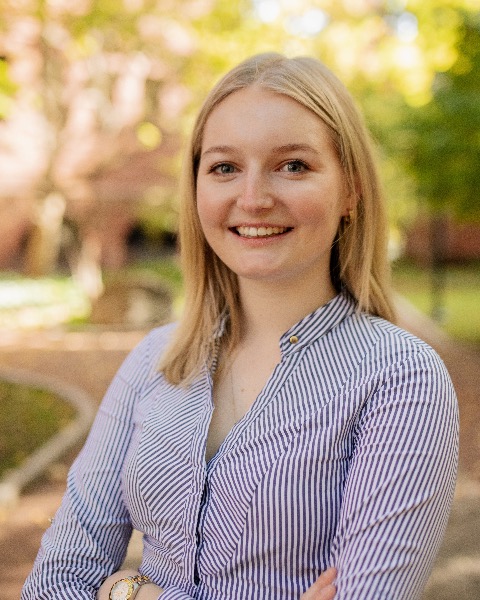Orthopedic and Rehabilitation Engineering
(H-288) Decellularized Meniscus Scaffolds and Cartilage Progenitor Cells for Total Meniscal Repair

Alexandra Dumas (she/her/hers)
Undergraduate Student
University of Pennsylvania
Philadelphia, Pennsylvania, United States- PG
Paul Gehret
Doctoral Candidate
University of Pennsylvania, United States - RG
Riccardo Gottardi
Assistant Professor
University of Pennsylvania, United States
Presenting Author(s)
Co-Author(s)
Primary Investigator(s)
The meniscus is a fibrocartilaginous tissue that acts as a shock absorber in the knee1. When the meniscus is damaged, erosion of articular cartilage can lead to osteoarthritis 2. The current gold standard for meniscal repair, the meniscectomy, removes the damaged portion of the meniscus causing increased contact forces between the tibia and femur. New approaches to meniscal repair such as cadaveric allografts have shown promise but are limited by donor availability, improper mechanical matching and limited infiltration from native cells leading to a 30% revision rate3. In leveraging the elastin fibers of the meniscus, we took a tissue engineering approach to create a decellularized meniscus (MEND) scaffold for meniscal repair that minimizes the shortcomings of current protocols.
Materials and Methods::
Selecting a cell source for Meniscal Engineering: Cells were harvested from Yucatan miniature pig ears via sequential enzymatic digestion and cartilage progenitor cells (CPCs) were separated from chondrocytes (CCs) via selective fibronectin adhesion. After 9 days of expansion, metabolic activity was measured by Alamar Blue assay. Cell pellets were differentiated for three weeks and compared via histology, immunofluorescence, and RT-qPCR to assess chondrogenic potential. Decellularization: Porcine menisci were sliced radially and devitalized by four three freeze/thaw cycles (-20ºC to 25ºC) and incubated in a pepsin-acetic acid solution on an orbital shaker (150rpm) ) at 37ºC for 24 hours. Microchannels were then created by elastase treatment for 24 hours. Cylindrical scaffolds were punched out from the posterior end of meniscal slices with biopsy punches (6mm). Cell Seeding and Differentiation: Decellularized scaffolds were seeded with 3x105 CPCs in transwell inserts. CPC infiltration was driven by a serum gradient of 1%- 20% FBS established across the transwell. After six days recellularized MEND underwent chondrogenic differentiation in chondrogenic medium for 3-6 weeks with medium changed twice/week. MEND constructs were later analyzed via histology, mechanical testing, biochemical assays and RT-qPCR. Integration: Native meniscal tissue was radially incised and cellularized MEND was sutured within the incision, and the MEND-repaired meniscus was cultured for up to three weeks and then assessed by histology for integration.
Results, Conclusions, and Discussions::
Results and Discussion: CPCs proliferated faster than CCs (Fig. 1A) and differentiated robustly as shown in pellet studies. Immunofluorescence revealed higher collagen II and lower collagen I and X content, indicative of hyaline cartilage. In contrast CCs demonstrated the opposite pattern in collagen brightness signals indicative of a more hypertrophic cartilage phenotype.(Fig.1B-G)CPCs were thus selected as a potentially superior cell source for cartilage engineering. Following decellularization, in MEND microchannels with an average diameter of 6.87μm were evident (Fig. 2 A-C), and DNA was removed to levels below 50 ng/mg dry tissue (Fig. 2 D). The microchannels allowed for recellularization with fully restored cell density after 6 days. After three weeks of differentiation, matrix remodeling by CPCs led to lacunae resembling white zone meniscal tissue (Fig. 3A&B). Following three additional weeks of differentiation CPCs secreted GAGs and collagen at levels similar to white zone and red zone native meniscus (Fig. 3C&D). Due to its low vascularity, white zone meniscus has traditionally been slow to heal as compared to its blood-vessel rich counterpart, the red zone. As such, creating a scaffold with the potential to match biochemical properties provides a potential candidate for total meniscal repair.
Conclusions: CPC-MEND scaffolds developed into engineered cartilage with properties similar to native meniscus, providing an exciting potential approach for total meniscal repair.
Acknowledgements (Optional): :
Support from: NIH (1R21HL159521-01A1, 1R01HL161583-01A1 NHLBI), Children’s Hospital of Philadelphia Research Institute, Frontier Program in Airway Disorders of the Children’s Hospital of Philadelphia, Ri.MED, Foundation (to RG), National Science Foundation Graduate Research Fellowship (to PMG), and Penn Undergraduate Research Mentoring Program and University Scholars (to AAD).
References (Optional): :
[1] Bilgen et al., Advanced Healthcare Materials, 2014[2] Logerstedt et al., J Orthop Sports Phys Ther. 2010, [3] Buma et al., Biomaterials. 2004, [4] Vaquero et al., Musc Lig Tend J. 2016.
